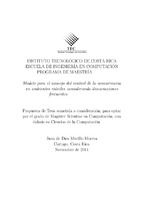Mostrar el registro sencillo del ítem
Modelo para el manejo del control de la concurrencia en ambientes móviles considerando desconexiones frecuentes
| dc.contributor.advisor | González-Alvarado, Carlos | es |
| dc.contributor.author | Murillo-Morera, Juan de Dios | |
| dc.date.accessioned | 2016-10-28T22:29:13Z | |
| dc.date.available | 2016-10-28T22:29:13Z | |
| dc.date.issued | 2014 | |
| dc.identifier.uri | https://hdl.handle.net/2238/6681 | |
| dc.description | Proyecto de Graduación (Maestría en Computación) Instituto Tecnológico de Costa Rica, Escuela de Ingeniería en Computación, 2014. | es |
| dc.description.abstract | The problem of concurrency control in the context of mobile devices has become an important research topic, since in the current society both cell phones and tablets, and other devices have been used to perform transactions such as canceling a receipt phone, buy a movie ticket, consult a bank account. The behavior of the crowd in mobile environments is a relatively new topic of study which has characteristics that di↵er from traditional approaches to database. The turnout in the computing environment appeared with the birth of operating systems with support for multiprogramming, and became a useful tool for getting the most out of a computer. Since then the competition has been applied to various computer applications such as databases, the Internet and multi-agent systems among others. Parallel processing and management of large volumes of data are more common nowadays. Therefore, management of transactions to the device and between devices through the intervention of a web service is more common. In turn, there are several issues facing mobile environments transaction level. For example, frequent disconnections and low bandwidth in mind that sometimes hinder the proper handling of transactions and endanger both their integrity and concurrency. To resolve this situation, have emerged algorithmic proposals which address the problem of concurrency control in mobile environments. However, they have always come limitations of any kind, because they use traditional methods for handling concurrency in mobile environments. Among the proposals there are some that are characterized as conservative, or holding locks or latches that often are not required, or simply contribute to a process that leads to a slow transaction processing thus preventing many transactions arrive to commit. Conservative proposals are used to manage mobile environments where the operations are local, thus achieving proper synchronization of these. For mobile devices, the problem begins in the time database transactions have not only local but also global, that is, there is a distributed heterogeneous environment. In situations like the one mentioned is where concurrency control becomes a difficult issue to resolve, especially when frequent disconnections occur. The proposed research has the main objective to study the most important both pessimistic and optimistic algorithms, as well as some nonconservative representatives to propose a new approach based on the salient features of the studied streams that can resolve the problem of concurrency control in environments considering the frequent disconnects. | es |
| dc.description.sponsorship | Instituto Tecnológico de Costa Rica. | es |
| dc.language.iso | spa | es |
| dc.publisher | Instituto Tecnológico de Costa Rica | es |
| dc.subject | Dispositivos móviles | es |
| dc.subject | Base de datos | es |
| dc.subject | Multiprogramación | es |
| dc.subject | Web service | es |
| dc.subject | Commit | es |
| dc.title | Modelo para el manejo del control de la concurrencia en ambientes móviles considerando desconexiones frecuentes | es |
| dc.type | info:eu-repo/semantics/masterThesis | es |
Ficheros en el ítem
Este ítem aparece en la(s) siguiente(s) colección(ones)
-
Maestría en Computación [107]


